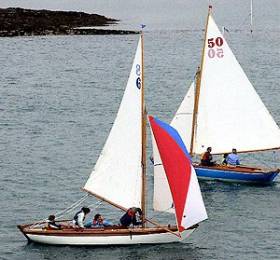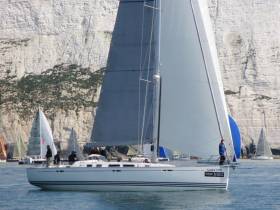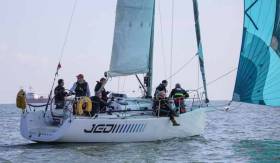Displaying items by tag: VDLR
VDLR 2023's Dubarry Ladies Lunch Raises €1,888 for Dun Laoghaire RNLI
Ireland's largest regatta, the Volvo Dun Laoghaire Regatta boasted almost 500 entries in July, that raised €1,888 for the Dun Laoghaire RNLI lifeboat charity at its sell-out Dubarry Ladies Lunch.
One of the social highlights of the four day regatta, the lunch was organised by Gina Luizzie and hosted by the Royal St. George Yacht Club at which actress Amy Huberman led the style charge.
The fundraising cheque was presented this week to Philip Ferguson on behalf of Dun Laoghaire RNLI by Gina and Volvo Dun Laoghaire Regatta Chairman, Don O'Dowd.
An initially discouraging weather pattern for July and an expanding fleet placed special demands on the organisers for the post-pandemic resumption of the biennial Volvo Dun Laoghaire Regatta.
But the broad shoulders of longtime administrator and current Chairman Don O’Dowd backed the efforts of Regatta Director Paddy Boyd to pull a remarkable success out of a very mixed period of sailing conditions, and the result was a diverse competition-filled waterborne sport in the very best Dun Laoghaire traditions, which go back to 1828 and beyond.
‘It’s a Platform for Us to Enjoy Our Sailing’: Nigel Biggs on the Secret of Checkmate XX’s 2023 Success
Checkmate XX won in the offshore class in Volvo Dun Laoghaire Regatta on Sunday (9 July), making it a double of offshore wins in the Sovereign and VDLR this season.
Prior to the event, Afloat.ie asked co-skipper Nigel Biggs about his and the team’s philosophy behind the Checkmate campaign. He was candid about their approach of putting enjoyment first, while also giving the younger generation a role to play.
That appears to be a winning combination, and one that should definitely lift spirits heading into their Fastnet Race challenge in the coming weeks.
 Dave Cullen (left) and Nigel Biggs with the Sovereign's Cup Offshore trophy won last month in Kinsale Photo: Bob Bateman
Dave Cullen (left) and Nigel Biggs with the Sovereign's Cup Offshore trophy won last month in Kinsale Photo: Bob Bateman
“The Sovereign’s was fun and we certainly enjoyed being back on the podium,” said Nigel, referencing the First 50 and crew’s achievement in late June.
 The next big target for the Checkmate XX crew is the Rolex Fastnet Race later this month Photo: Bob Bateman
The next big target for the Checkmate XX crew is the Rolex Fastnet Race later this month Photo: Bob Bateman
“When we bought Checkmate XX last year, we did so in the knowledge that she wasn’t a successful race boat, more a platform for us to enjoy our sailing, as age begins to catch up with us, whilst also trying to encourage more younger people into keelboat racing,” he added.
 Some of the Checkmate XX crew at the Volvo Dun Laoghaire Regatta prizegiving Photo: Michael Chester
Some of the Checkmate XX crew at the Volvo Dun Laoghaire Regatta prizegiving Photo: Michael Chester
“The plan appears to be working as we have already had some great times, sailing with friends both old and new.”
Elaborating on the importance of encouraging younger sailors, Nigel said: “Young people are the future of our sport and having discussed with some of them the reasons why they haven’t previously got involved in keelboat racing, we are trying to remove the perceived obstacles so they, both male and female, feel they can become valuable members of our crew, learning more about the sport and having fun along the way.”
As regards Checkmate XX’s stronger performance in 2023, Nigel said the answer is a simple one: using experience as a learning opportunity.
“The improved performance of the boat is not so much about rating optimisation; anyone can do that,” he said. It has more to do with the time we have spent thinking about the lessons of last year and working to improve the way we sail the boat, particularly in the conditions in which she was less competitive.
 (Above and below) Co-skipper Nigel Biggs on the helm of Checkmate XX in an early season light airs ISORA race Photo: Afloat
(Above and below) Co-skipper Nigel Biggs on the helm of Checkmate XX in an early season light airs ISORA race Photo: Afloat
“We have been fortunate to already have more hours under our belts this year than we managed in the whole of 2022, in a variety of conditions and are developing a better idea of what the boat likes in terms of rig setup, weight distribution and trimming, every time we go out.”
Nigel was modest about the team’s expectations for the VDLR, and harbours similar feelings for the Fastnet, “but if we continue to have as much fun with the great group of people we sail with, that is all the success we need”.
Get Pfull of Pfizer & Sail for Ireland
Welcome to Nautical Limbo Land. This weekend may see the annual start-of-season lift-ins – with masked-up socially-distanced protocols - at the Dun Laoghaire Motor Yacht Club, the National YC, and the Royal St George Yacht Club in Dun Laoghaire. But as was discussed here a week ago, it will be somewhere around the 20th April before it's clear whether or not the inevitable behind-doors socialising of the Easter Weekend has led to a fresh peak in the currently almost-plateaued pandemic infection rate. And officially it's 26th April before limited activity will be permitted in specialised outdoor sports such as tennis, sailing and golf.
There are those – particularly lone sailors of every hue from paddleboarders to top Laser performers – who have been pushing their particular envelopes to the absolute limit afloat. But equally, there are those for whom sailing simply isn't worth resuming until it re-emerges – if it ever does – as the carefree sociable activity of yore, in which skills of seamanship and sailing techniques are as important as ever, but you no longer find your activities hampered at every turn by considerations of social distancing and bubble maintenance.
 Out on his own - the lone kite-surfer in Dublin Bay is at much less risk of COVID infection than the passengers on the cross-channel ferry
Out on his own - the lone kite-surfer in Dublin Bay is at much less risk of COVID infection than the passengers on the cross-channel ferry
A crisp email from a sociable skipper sums it up: "Whatever other crews may be doing, our lot aren't going racing again until we're all Pfull of Pfizer". Now that's telling it like it is. But the ultimate nationwide logistical challenges in fulfilling its demands scarcely bear thinking about.
Nevertheless "Get Pfull of Pfizer and Sail for Ireland" has quite a ring to it, and it makes for an inspiring aspiration. But as we've learned through the long and dreary unwinding of the Great Pandemic Experience, predictions of when and how we can resume specific activities are very difficult to make with any real accuracy, mainly because they involve the future. And it emerges that the supposedly smooth-running roll-out is neither smooth nor rolling, as yet another glitch emerges somewhere along the line in the supply chain and the supply train moving it.
 There they are – gone…..Today (Saturday's) lift-in at the National YC is one of three similar club operations this weekend in Dun Laoghaire. Photo: Afloat.ie
There they are – gone…..Today (Saturday's) lift-in at the National YC is one of three similar club operations this weekend in Dun Laoghaire. Photo: Afloat.ie
Time was when trains were a matter of romance and song, but this has all become so deadly serious that's it's just not on to envisage The Vacc-Supply Train as a topic for a hypnotically rhythmic railroad song on the lines of The City of New Orleans (Willie Nelson your only man), or the Rock Island Line, and even less so with The Orange Blossom Special.
So we keep the head down and plod on towards late April, sustained and encouraged by the knowledge that in the brief suspensions of Lockdowns last summer, Ireland was indisputably a world leader in providing local racing and offshore challenges which stayed within guidelines, and yet managed to keep our sport and many of our clubs alive and active, albeit in an often decidedly muted way.
 Sister power…..the Murphy family's Grand Soleil 40 Nieulargo – with one of the sisters on the helm – cutting a dash in the first evening race of the truncated 2020 Royal Cork YC Club Programme on Thursday, July 9th. In addition to club racing, Nieulargo won both the Kinsale-Fastnet-Kinsale and the Fastnet 450 Races to be "Boat of the Year". Photo: Robert Bateman
Sister power…..the Murphy family's Grand Soleil 40 Nieulargo – with one of the sisters on the helm – cutting a dash in the first evening race of the truncated 2020 Royal Cork YC Club Programme on Thursday, July 9th. In addition to club racing, Nieulargo won both the Kinsale-Fastnet-Kinsale and the Fastnet 450 Races to be "Boat of the Year". Photo: Robert Bateman
This was done through quiet and thorough behind-the-scenes planning and organisation in order to minimise the shore-crowd element of any event, sometimes to the point that a compliant event might be taking place afloat, but there wasn't a soul to be found ashore, with Dublin Bay SC setting the pace by moving their entire race administration activity aboard their Committee Boats.
Thus in the current febrile national sporting mood, with recreational control freaks ready to leap on anyone making plans for some sporting activity that starts to explore the limits of what's possible, we wouldn't dream at the moment of contacting those who successfully organised special events last year and will be expected to do the same this time round. And equally in the current fluid situation, now is not the time to challenge those who have flagged significant events for the early to mid part of the hoped-for season to confirm definitely whether or not those events will actually happen.
 By moving their entire Race Administration operation aboard their Committee Boats, Dublin Bay SC succeeded in running a comprehensive COVID-compliant programme in 2020 which resulted in the club's acclamation as the Mitsubishi Motors Club of the Year
By moving their entire Race Administration operation aboard their Committee Boats, Dublin Bay SC succeeded in running a comprehensive COVID-compliant programme in 2020 which resulted in the club's acclamation as the Mitsubishi Motors Club of the Year
That said, from last year we have some knowledge of what can be made to work. Other things being equal, keep it local and keep it on the water – offshore if need be – and you're half way there. Beyond that, keep it young. We know that sailing is always reaching out to more senior age groups for introductory courses, but the fact is the potential infection rate tends to decline with a younger cohort, and young people have a greater need to be shown how to be doing something than older folk who, having reached a certain stage in life, should have sufficient reserves of character to think and act for themselves in a regulation-compliant way.
Even when a limited amount of post-race shoreside socializing was permitted last year, it was found that there were many who were more than satisfied to go quietly afloat, have their race, then stow the boat afloat or ashore, and simply go straight home again.
VOLVO DUN LAOGHAIRE REGATTA HITS THE SPOT
 VDLR Chairman Don O'Dowd was ahead of the curve in leading his Committee into organising a re-structured two-part regatta to cope with post-pandemic conditions
VDLR Chairman Don O'Dowd was ahead of the curve in leading his Committee into organising a re-structured two-part regatta to cope with post-pandemic conditions
So in trying to move what's implicit in this behavioural pattern on to a larger scale, the clear message is that "local-ness" is the essence of it all, and the biennial Volvo Dun Laoghaire Regatta – while having a significant international element in its eclectic entry list – must be unrivalled in the number of participants who live right beside or within easy distance of Dun Laoghaire Harbour.
With the regatta being served by four club and forecourt complexes - three of which are notably spacious - together with the shore space at the marina, any crowd pinch-points can be easily controlled, and yet you're dealing with overall crowd numbers which would swamp many a smaller venue in a non-compliant way.
 The Water Wags and other One-Designs will have their Volvo Dun Laoghaire regatta from July 2nd to 4th
The Water Wags and other One-Designs will have their Volvo Dun Laoghaire regatta from July 2nd to 4th
Beyond that, Chairman Don O'Dowd and his Organising Committee put themselves even further ahead of the curve more than a year ago, when they announced a pandemic-induced re-framing of the regatta format into two extended weekends, one devoted to One Designs (2-4th July) and the other to Cruiser-Racers (8th to 11th July).
In these difficult times, classes have leapt at the convenient opportunity to make the VDLR one of their regional championships, or even the national championship itself. Overall, entries are already running beyond the 300 mark, and with Early Bird Entry still available until April 16th, this has a refreshing air of certainty about it, a classic case of a problem situation being turned into an opportunity to create something exciting and new.
 Cruiser-Racer action in the Volvo Dun Laoghaire Regatta – this year, their Regatta will be the long weekend of July 8th to 11th. Photo: Afloat.ie/David O'Brien
Cruiser-Racer action in the Volvo Dun Laoghaire Regatta – this year, their Regatta will be the long weekend of July 8th to 11th. Photo: Afloat.ie/David O'Brien
Nevertheless we'd argue that in mid-April with some disturbing international pandemic statistics emerging, it is pointless and indeed irritating to constantly chivvy organisers of other proposed events as to whether or not their fixture is going to take place.
You'll know the events we mean. And we'd argue that any owner-skipper who – in the current exceptional circumstances – finds it beyond his or her capabilities to firm up a challenge crew at just three weeks notice (or perhaps even less time) may well be somewhat out of their depth in the first place. Meanwhile, others find their way as best they can through a changing sea of circumstances.
 Once upon a time…..in times past, as at the Kingstown Harbour Centenary VDLR Regatta in 2017, social distancing was unknown, but for 2021 things will have to be done differently. Photo: VDLR
Once upon a time…..in times past, as at the Kingstown Harbour Centenary VDLR Regatta in 2017, social distancing was unknown, but for 2021 things will have to be done differently. Photo: VDLR
Trearddur Bay’s Myths & Seabird Half Raters To Cross Irish Sea For Dun Laoghaire Regatta
#VDLR - Trearddur Bay Sailing Club brings its centenary year celebrations to Dublin Bay this summer as a number of its Myth class and Seabird Half Raters will be making the trip across the Irish Sea for the Volvo Dun Laoghaire Regatta.
Myths are one of the original classes raced since the Holyhead club’s inception in 1919, with three of the 14-footers joining a fleet of five 12-foot Insects — three of the latter, the first boats built for the club, having been restored for the centenary.
While no original Myths remain from those days, the open boat class has seen a resurgence in recent years, and a modern Myth fleet at Trearddur Bay has grown to over 40 vessels.
Designed along the lines of the International 14 but inspired by what the club calls “a hotch-potch of ideas”, Myths are distinguished as much by their tight specification as their turkey red sails and either white-painted or varnished hulls that comprise five different types of wood.
With the Myth class now in its 99th year, its lasting legacy is no doubt also connected to the boat’s particular suitability to the environment of Trearddur Bay — not to mention the absence of an age barrier when it comes to racing, as young and old can compete on equal terms.
They are matched by the Seabird Half Rater — which was adopted in 1922 and is one of the oldest one-designs still sailing in British waters — at a club which currently has a strong dinghy scene with Mirrors, Fevas and Optimists among a full member list of more than 1,100 that sails every August.
Due to the uniquely short season, Trearddur Bay’s members regularly sail and race at other clubs, so some of the contingent will likely be no strangers to the waters of Dublin Bay as they join the likes of Olympic medalist Mike McIntyre at the biennial regatta — and Ireland’s largest sailing event — from 11-14 July.
The entry form for the Volvo Dun Laoghaire Regatta 2019 is available HERE. Early bird entry fees are available up to Sunday 31 March.
Howth Yacht Seeks Crew For Dun Laoghaire Regatta
#VDLR - Howth Yacht Club has put out the message that one of its member yachts, the XC45 Samatom, is seeking crew for the Volvo Dun Laoghaire Regatta from 6-9 July.
Anyone interested in joining the crew for the weekend’s sailing on the yacht, which has recently been fitted out with new North Sails, is requested to contact Criostoir McCormack at 086 608 2511.
Crews are also needed on various boats taking part in the pre-regatta Lyver Trophy offshore race from Liverpool to Pwllheli next weekend, and in the regatta itself the week after.
Get in touch with Peter Ryan at [email protected] who will pass your details along.
INSS J109 Available for Dun Laoghaire Regatta Charter
The Irish National Sailing School J109 yacht is available to charter for Volvo Dun Laoghaire regatta and other Irish sailing events this season.
Jedi is a highly competitive J109 yacht and part of DBSC's ultra–competitive Class One fleet of 20 boats on Dublin Bay.
Regular readers of Afloat.ie will know the J109 class in Ireland needs no introduction, the cruiser racer offers exciting and exhilarating sailing yet in a very user friendly and comfortable package.
Jedi is, according to the INSS's Kenny Rumball, 'a perfect example of the J109 having undergone an extensive refit over the winter of 2016-2017 to make her possibly the most IRC optimized J109 available in Europe'
Download the INSS spec sheet below
Dun Laoghaire Regatta 2015 Sailing Instructions Online Here!
#vdlr –With an entry list the envy of regatta organisers everywhere, July's Volvo Dun Laoghaire Regatta (VDLR) has received a massive entry of 302 boats so far with three months to run to its first gun. Over 63 different yacht clubs are represented in a fleet that will split into 20 different sailing classes for the four day extravaganza at the Irish east coast port. Enthusiastic insiders say the tenth anniversary of the event may yet hit its all time high of 500 boats by July 9 but a more modest reckoning of 400 plus will certainly match the 2013 and 2011 editions of Ireland's largest sailing event.
Run by the four waterfront clubs of the DMYC, RIYC, NYC and RSt.GYC's this year's event is under the stewardship of former Fastnet race winner Tim Goodbody and Dragon Edinburgh Cup winner Martin Byrne. An overview of the biennial event was published by Afloat.ie last weekend in WM Nixon's blog here.
The bulk of entries come from the Dublin Bay area itself but there is also strong interest from along the east coast from Greystones, Arklow, Howth and Skerries. Most encouragingly, the event is proving to be a draw for boats from further afield too with entries from across the Irish Sea some of the first to sign up.
As previoulsy reported by Afloat.ie, the following events are confirmed as part of the event:
Royal Dee Yacht Club Irish Sea Offshore Championship
J109 Irish National Championship
RS Elite Irish National Championship
Beneteau First 21 Irish Championship
Wayfarer Irish National Championship
GP 14 Leinster Championship
J24 Leinster Championship
In encouraging news for dinghy sailing (that has separately been given a shot in the arm this year by local DBSC organisers), it looks like VDLR will also see a lift for centreboard classes. 2015 will see a record number of dinghies classes participating. In addition to the regular one designs such as the Mermaid, Flying 15, Squib, Fireball, IDRA 14 – organisers are welcoming the GP14, Wayfarer, RS200/RS400, Laser classes to the regatta with their own starts.
It is the first visit to the Regatta for the GP14 fleet and organisers are very much looking forward to welcoming the class, all of whom will be from visiting clubs from around the country. An expected entry of 40 GP14's are expected and they will be hosting their Leinster Championships as part of the Regatta.
The Wayfarers are returning after running their a successful UK Nationals within the 2011 Regatta and this year they will be running their Irish Nationals, an expected entry of 20 visiting Wayfarers are expected.
Big entries are also expected from both the Laser and RS fleets. It still remians to be seen if the PY class can muster sufficient numbers.
VDLR had issues recently with its online payment. To accommodate anyone who has had difficulties it has extended the early bird discounted entry fee offer deadline to Friday, April 17th.
#vdlr – The "suburban sailfest" which is the biennial Volvo Dun Laoghaire Regatta this year (Thursday July 9th – Sunday 12th July) is marking its tenth anniversary with the sixth edition. It's a classic Irish mix of sailing sport at all levels aboard a wide variety of boats from many and often very distant places, combining to sail with the large home fleet in Dublin Bay in thirty different classes. And on each of the four days, colourful action afloat is followed ashore by a hectic pace of post-sailing celebrations in four waterfront clubs.
Three of these are venerable institutions with their origins in the midst of the 19th Century, and their homes in historic harbourside buildings each of which is, in its own way, an architectural masterpiece. And even the "newest" of the four waterfront clubs, the Dun Laoghaire Motor Yacht Club, is this year celebrating its Golden Jubilee.
The VDLR 2015 has much to live up to, but in the spirit of this youthful event in a mature setting, the people running it bring the necessary level of enthusiasm and expertise allied to unrivalled experience to maximize the enjoyment of a unique experience. W M Nixon casts an eye over something special.
"You have to remember that it's a regatta, not a championship. Enjoyment of sport comes first, and the purity of fierce competition second. But of course we're going to provide the best possible starts. And the intention is to have those starts leading into the best possible courses in the conditions prevailing."
"Yet the way we see it, people should be racing just as soon as possible after leaving the harbour. There's nothing which impairs simple sailing enjoyment so much as having to wait around in a perfectly good but maybe slightly fickle sailing breeze, hanging about in frustration while an overly-pernickety Race Officer dithers over setting the absolutely perfect start line".
If these were the words of some club's entertainment officer concerned with creating a good mood at some event no matter what happens in the racing, we'd treat them with some caution. But the speaker is not only a former and very actively sailing Commodore of two of Dun Laoghaire's most august yacht clubs, he's a helmsman/owner who has won championships to the top level in boats like the International Dragon and the International J/24.
He was also, in 1987, the lead helmsman on a 40-footer racing in the Irish Admiral's Cup team with such competence that he out-performed the legendary Lawrie Smith on a sister-ship during a tacking duel in the AC inshore events in the Solent, and then went on to be a lead helm when that boat won the Fastnet Race overall to conclude the series. More recently, he continues at the top level as one of the most successful owner-skippers in his Sigma 33 Offshore OD.
Welcome to the world of Tim Goodbody, sailing enthusiast extraordinaire, and the Chairman of the Organising Committee for Volvo Dun Laoghaire Regatta 2015. With all due respects to the three previous incumbents of this demanding post, he is the one with the most comprehensive record of personal sailing achievement in racing. So when he talks of "getting people out and racing just as soon as possible after leaving the harbour", we can be quite sure that the standards of start-line and course setting will be world class, as his stellar and continuing sailing career is allied to a formidable CV of involvement in sailing administration afloat and ashore.
Thus he was instrumental in devising the courses now used by Dublin Bay SC, and when Commodore of the Royal Alfred YC more than thirty years ago he led the way in developing the Superleague which set the standard as a season-long racing series at the time. Then as Commodore of the Royal Irish YC, he deftly combined the necessary roles of curator, committee man, accomplished owner-skipper and a public face of Dun Laoghaire sailing generally and one of Ireland's oldest and most distinguished clubs in particular.
With entries from 55 different clubs from all round the Irish Sea and further afield already in as the boats listed went through the 200 mark yesterday, a surge is expected ahead of the closing of the special early entry discount next Tuesday March 31st, and the VDLR 2015 administrative machine is fully in action to maximise an event which sees the old granite pond which is Dun Laoghaire Harbour embrace 21st century sailing.
It's pretty good going when you think that in two years time this totally artificial harbor will be shaping up to begin celebrating its Bicentenary, which can go on for as long as you wish, as the harbour was started in 1817, but it hadn't been sufficiently completed to stage a regatta until 1828.

The first regatta at Dun Laoghaire in 1828
Back then, some early yachtsmen staged match races between their often enormous yachts which tended to be based on the designs of the Revenue Cutters which were the fastest sailing vessels of their day. The prizes were appropriately enormous money purses of which a large proportion went to the sailors, so the professional crews raced with real aggression, and all sorts of devilish sabotage on the opposition was par for the course.
However, yacht racing was still in its infancy and while some owners were keen to do it, others – such as the Marquess of Anglesey who was one of the inspirers of this first event – were happier just to sail around displaying their extraordinary vessels to crowds which had never seen anything quite like it before.
The holding of more regular regattas in what was then Kingstown became part of the annual social season. Though the Royal Irish YC was the first club into being in 1831, it soon languished and it was the establishment of what eventually became the Royal St George in 1838 which made such annual regattas a key part of the annual high society season.
In other words, the events and personal displays ashore and along the waterfront were seen if anything as more important than the racing afloat. Then as now, the true sailing enthusiasts found this an annoying state of affairs, so they took to devising ways of making the sailing more important, rather than just a background to the various dramas and entertainments taking place ashore.
Doubtless the idea had been tried earlier, but in 1860 there was certainly an attempt at an early regatta week. By this time the Royal St George clubhouse had greatly expanded, and the Royal Irish was re-invigorated in its relatively-new1851-built clubhouse. Several days of racing were held with the local large-yacht flotilla enhanced by craft from the south coast. And then, as many of the vessels were headed back to Cork Harbour afterwards, the Admiral of the Royal Cork, Thomas G French, suggested an offshore race between Dublin Bay and Cork Harbour which duly took place, one of the world's very first genuine passage races.
In all, 15 yachts took part, but not all did so with the same urgency. Seven went away promptly as though it was really a race, but the remaining eight crossed the start line at different times within the next hour.
Ironically, the finish times two days later came down to a matter of minutes. The 90-ton schooner Kingfisher was first into Cork Harbour but a beat to the Royal Cork YC finish line at Cobh against the ebb was not at all to her liking, and the 80-ton cutter Peri took the lead. But then in tricky conditions in the harbour the even smaller 39-ton cutter Sybil managed to take the lead under the command of amateur skipper Henry O'Bryen, and hung onto to it to scrape across three minutes ahead of Peri with Kingfisher two minutes later.
Thus all the excitement and interest focused on the in-harbour stages. Back in Dublin Bay, this was proving the case with the new harbour, with one of the stars of Kingstown sailing drama at this period being Belfast linen magnate John Mulholland's legendary 1865-built schooner Egeria, which made a speciality of sweeping up to the finish lines right in close off the clubs with all sails set.
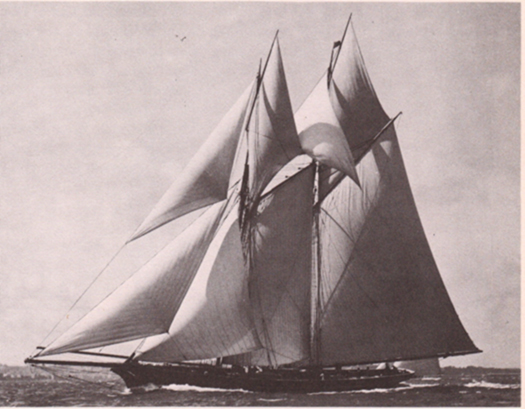
The successful 1865-built schooner Egeria, owned by John Mulholland from Belfast, was renowned for racing right up to the waterfront in Dun Laoghaire with all sail set
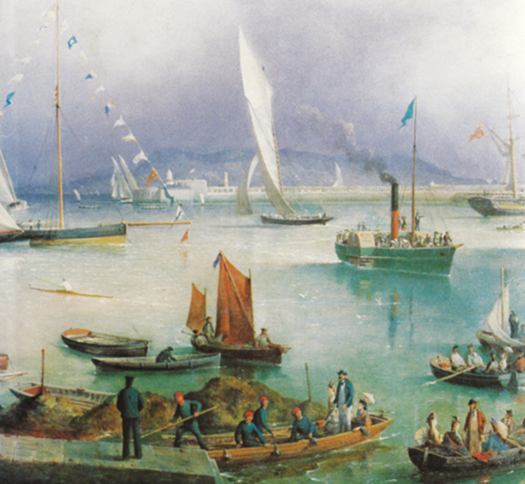
Classic Dun Laoghaire regatta scene by Richard Bridges Beechey. Courtesy RStGYC
The marine artist Richard Breeches Beechey made a speciality of recording these Dublin Bay dramas, and the enthusiastic owners were there to act their roles, no more so than John Jameson of the eponymous whiskey firm, whose successful cutter Irex was a star contender at major regattas all round the coasts of Britain and Ireland. When Irex was back in Dublin Bay, the crowds gathered, for in those days of much more limited entertainment, big boat racing was a must-see spectacle.
Yet at the same time there was something of a revolution going on in sailing, with the racing sport being codified in a movement largely led by the Royal Alfred YC, while small boat racing came centre stage when the Dublin Bay SC was established in 1884, with the one design concept making its appearance with the 13ft Water Wags in 1887.
This was all well and good for the underlying health of sailing. But for traditional yacht clubs with impressive premises which were ultimately there for the great and good to get involved with high end yachting at the height of the summer season, it was a mixed blessing, as each club's annual regatta tried to be all things to all sailing men and the few sailing women, while at the same time keeping the pavilion members happy.

In an age of less sophisticated entertainment, robust waterfront sports were an integral part of the Edwardian era regatta at the Royal St George YC. Photo courtesy Theo Harris
With yacht sizes decreasing, the spectacle and style which under-pinned a classic regatta were increasingly lacking, and while each club's stand-alone annual regatta continued as the centrepiece of its summer programme until well into the late 20th century, the increasing length and variety of the sailing season, and the easy accessibility of other sailing events for specific classes, meant that the traditional Dun Laoghaire regatta was becoming a threatened species.
So in the late 1940s when the newly-formed Irish Dinghy Racing Association was finding success with its annual Dinghy Week at popular sailing venues all round the coast, inevitably there began to be talk of a Regatta Week among the clubs in Dun Laoghaire, with the inevitable comparison to the success of Cowes Week being used to encourage the idea.
You will still hear the comparison to Cowes made from time to time, so let's get something off our chest. There is simply nowhere quite like Cowes. It's on an island, at the epicentre of a very interesting stretch of sailing water. And relatively few people live there. So when the annual Cowes Week is staged, almost every participant is a visitor. To a great extent, this is what makes it special.

The VDLR is ideal for a spot of family racing in all classes including the venerable Water Wags, but this serene mother and daughter crew combination aboard the family Wag is just ever so slightly different. Both are Olympic sailors. That's Cathy McAleavey (470 in 1988) on the spinnaker trim, and her daughter Annalise Murphy (Laser radial in 2012) is on the helm. Photo: VDLR
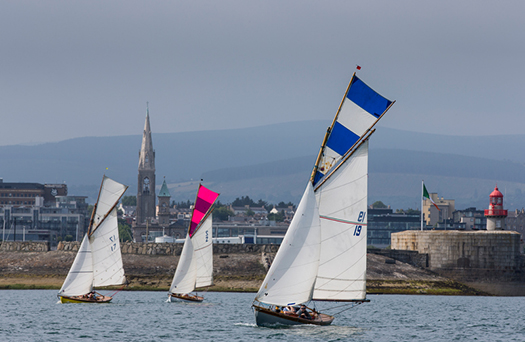
The Howth 17s – established 1898 – make the biennial pilgrimage across Dublin Bay to race in VDLR. Photo: VDLR
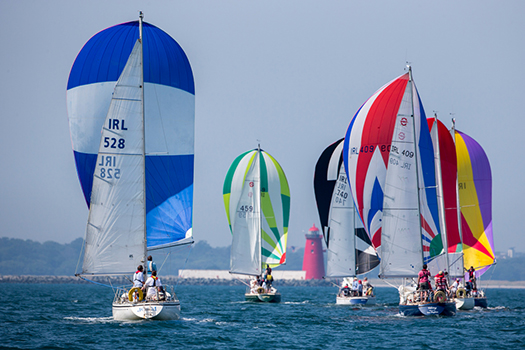
The Shipman 28s may be seen as handy little cruisers at other sailing entres, but in Dun Laoghaire they race as a one design class. Photo VDLR
But at many other sailing places in general, and in Dun Laoghaire in particular, you're right at the heart of a large and affluent resident population. The underlying atmosphere is inherently different, and any successful Dublin Bay event with a regatta flavour has to bear this quietly in mind if it's going to be a success.
Be that as it may, by the mid-1950s a Dun Laoghaire Regatta Week had been rather tentatively introduced, but the Irish economy was so depressed throughout that dismal decade that it was never a runaway success, and without any specifically Irish sailing media to record it, we know virtually nothing of what happened, and in any case it didn't last.
Yet boat numbers were increasing, so for a while the traditional annual Club Regatta had something of a heyday with the perfect balance between fleets afloat and the lack of too many distractions by other sports and interests ashore. For a brave new era, the annual regatta with the clubhouses bedecked in bunting was quite the thing.
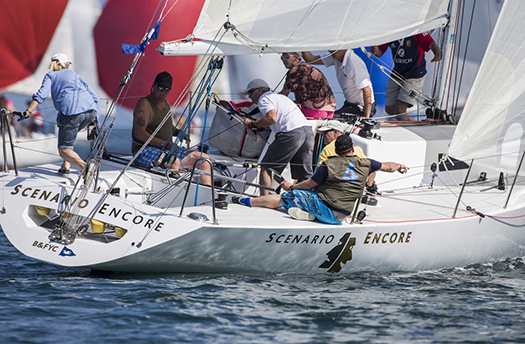
You don't absolutely have to go to Lancashire if you want to recruit a tattooed crew, but it helps. This is Scenario Encore from Blackpool & Fleetwood YC at VDLR 2013. Photo: VDLR

Ever get the feeling that everybody wants to be in the same place at once.......? Photo: VDLR
However, sailing was developing, and there came a new emphasis in the 1970s on offshore racing This in turn led to events like ISORA Week which could be tailored to match the established regatta programme. But then life patterns changed again, offshore racing was seen as almost anti-social, and club officers cast around for a re-shaping of the programme which would provide a compact event which had contemporary appeal for busy people who had many other interests to attend to and obligations to fulfill.
It was three or four years after the turn of the Millennium that the four Dun Laoghaire clubs tasked a working party of their junior flag officers with devising a regatta format which would suit the needs of the 21st Century. Somewhere out there, there has to be an individual original thinker who first proposed the key concept of a four day event evenly spread across all the clubs. We salute him or her, whomsoever they may be. But it went through so many modifications and mutations that the Dun Laoghaire Regatta, as it was first launched some time in late 2004 with the first one scheduled for 2005, had become a completely novel fixture, something carefully tailored to Dun Laoghaire as it has become today, taking into account the way of life of the people who sail from this great and unique port, and the expectations of the people who come to sail with them at their biennial suburban sailfest.
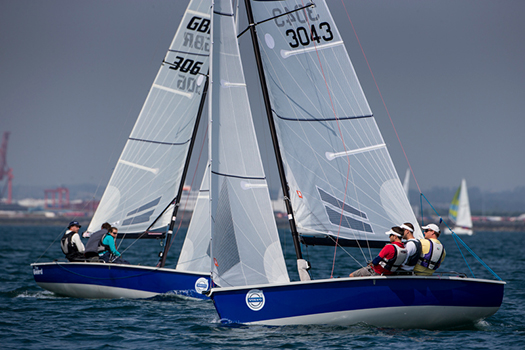
Perfect racing for the SB20s at VDLR 2013. Photo: VDLR
Even in its earliest forms it was such a novel concept that it clearly required someone very special to head up its nascent organising committee, but that was soon put on the right track with Brian Craig of the Royal St George YC put in charge as Chairman. Craig – the quintessential can-do backroom boy who so doggedly remains a behind-the-scenes figure – realised that careful diplomacy was needed if his new committee was going to avoid treading on established toes in the four existing club administration structures.
So he advertised for an administrative secretary with significant experience in office organisation and sailing, yet without any direct personal links to any of the Dun Laoghaire clubs. You'd have though this an almost impossible order with its very specific and unusual job-spec requirements, but they filled the bill precisely with Ciara Dowling. She'd grown up in the Irish countryside with no connection to boats or sailing, yet on any visit to Dun Laoghaire she'd felt drawn to the sport. However, it was while working in London as an office manager in her mid-twenties that she got involved afloat through a corporate outing for a rough day's sailing in the Solent, and was soon hooked while everyone else was sea-sick.
Working in sailing of any kind became her ambition, but it didn't always work out smoothly, yet she managed to put in a formidable amount of sea time and during a period back in Ireland she got signed up for one of the Irish crews (skippered by Tom McWilliam) in the Teachers Round Britain Challenge. By this stage she was finding sailing berths in Dublin Bay while moving between Ireland and London wherever there was boat-related work to be found, but at the time the notice for the Dun Laoghaire Regatta secretary was posted she was living in Howth and had become a member of Howth YC, but was not a member of any Dun Laoghaire club. That seemingly impossible job-spec outline had been hit on target.

Ciara Dowling with her gentlemen friends. The VDLR Secretary with the Chairmen who are (left to right) Tim Goodbody (2015), Adam Winkelmann (2011-2013), Phil Smith (2009), and Brian Craig (2005-2007).
Running what is now the Volvo Dun Laoghaire Regatta is not a full-time job, but as it rolls on through its biennial reincarnations, Ciara Dowling's unrivalled experience of the VDLR in particular and event management in general gives Dun Laoghaire sailing a very smooth management team for an event which can be constantly modified to suit changing tastes, while also competently dealing with a rush of last-minute entries if a good weather forecast comes along, as happened in 2013.
With the discount deadline looming next Tuesday, we'll leave fuller consideration of the fleet for a future date, but be sure that there are plenty of hot boats already in, boats of the calibre of Conor Phelan's Ker 36 Jump Juice from Cork which was pace-setting in Dublin Bay at the ICRA Nationals last year, and also already in the listings in what promises to be a very hot J/109 championship is Liam Shanahan's Ruth from the National, ISORA hotshot and oh-so-nearly winner of last year's Round Ireland.

The VDLR is one of the biggest annual gatherings for the historic IDRA 14 class. Photo: VDLR
And though the mood of the regatta is such that the organisers are very wary of declaring an overall winner, the feeling on the waterfront was that 2013's had been Nigel Biggs' classic Humphreys Half Tonner Checkmate, which has of course recently been sold to Dave Cullen of Howth and is a certain contender this summer.
It takes a while to get your head round the notion of 30 classes (or maybe now it's 31 with the RS Elites throwing their hats into the ring yesterday), and they'll be racing in six different areas under the direction of Race Officers of the quality of Jack Roy and Harry Gallagher.
In all, there are 150 volunteers involved, with a veritable fleet of support RIBs, so every day what mounts to a small navy is going to set out to go to sea to provide what is hoped will be some very special sport.
Tim Goodbody has only been in the chairman's job since the end of last summer, which he feels gives little enough time - he would recommend that any successor gets his feet under the table immediately after the St Patrick's Day holiday in the previous year. In other words, he reckons an absolute minimum of 15 months is required to maximize the success of this unique event.
But as he gets to grips with it, he is effusive in his praise for the support of the Dun Laoghaire Harbour Company, while the continued backing of Volvo through their people at Spirit Motors has kept the show on the road. The regatta's founding in 2005 saw it come into being just as the economy was starting to overheat, yet Volvo came aboard in 2007 and has stayed on as a great pillar of support.
But in the end, the success of it all will come down to you - the competitors. Let us hope that what we've outlined as the long and varied story of regattas in Dun Laoghaire will add to the richness of your experience, and the deeper meaning of an event of this type being held in Dublin Bay. It's no exaggeration to assert that racing in VDLR 2015, no matter what boat you may be sailing, is sailing the dream while being an active part of living history with a future dimension.
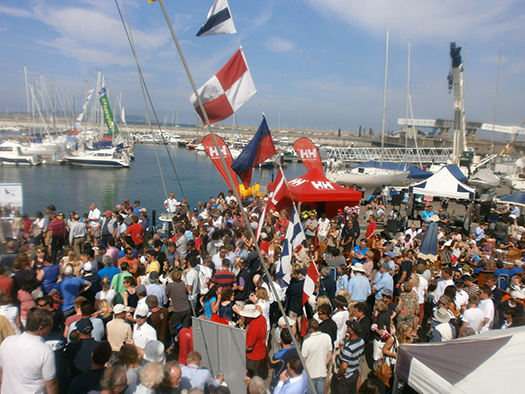
It has been described as "Leopardstown-on-Sea", but it's much better than that......Photo: VDLR
The 2015 Volvo Dun Laoghaire Regatta Programme (with a full entry list) will be published in late June as a supplement to Summer Afloat magazine
Volvo Dun Laoghaire Regatta 2015 Signs Up UK Entries
#vdlr – Up to 15 entries have already been received for what is expected to be Ireland's biggest sailing event in 2015. Among the early entries for Volvo Dun Laoghaire Regatta (VDLR) is a number of Scottish, English and Northern Ireland boats that responded almost immediately to the online publication of the July regatta's Notice of Race.
Among the first was Clyde Cruising Club's Wildebeest V skippered by Craig Latimer. Fairlie Yacht Club's MAT 1010 Now or Never 3 sailed by Neill Sandford is also in for VDLR 2015.
Class bands have yet to be set for cruiser classes but already expressions of interest received at Dun Laoghaire Race HQ indicate a strong take up from overseas entries for the 2015 biennial, organised by all four Dun Laoghaire waterfront yacht clubs.
Other boats that have expressed interest or already entered are Stuart Cranston's Sigma 35
from Down Cruising Club. The GBR registered Beneteau First 36.7, Animal skippered by Kevin Aiken is coming and so is the Élan 333, Movistar Bleu from Killyleagh under Raymond Killops. Guy Cowper's Stratisfear, a Corby 36, from Royal Dee is also heading west for Dun Laoghaire.
At this early stage, as Afloat.ie reported earlier, the following events have also been confirmed as part of the Volvo Dun Laoghaire Regatta line–up.
• Royal Dee Irish Sea Offshore Challenge
• J109 Irish National
Championship
• RS Elite Irish National
Championship
• Beneteau First 21 Irish
Championship
• Wayfarer Irish National
Championship
• GP 14 Leinster Championship
• J24 Leinster Championship




























